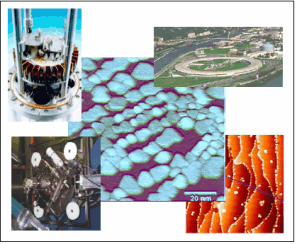NanO2
Oxidation of Nano-Materials
 Understanding the oxidation of surfaces, interfaces and nano-particles under ambient oxygen pressures and the technical ability to atomically control the oxidation of nano-materials under industrially and environmentally relevant conditions are considered to be important milestones for future nano-technologies. In fact, the potential of nano-technology to forge innovations and improvements in the chemical, automotive, environmental, electronic, and energy sectors is to a large extent limited by a lack of understanding regarding nano-oxidation. The control of oxidation under operational conditions is of utmost importance for the enhanced performance of catalysts involved in applications ranging from fuel cells and chemical production to electronic sensors for automotive and environmental monitoring applications. Oxidation under ambient conditions determines the stability, functionality and long term performance of metallic particles in their working environment. To achieve sustainable growth in nano-technology, a deep and systematic understanding what parameters of the nano-materials control its behaviour under ambient oxygen pressures is mandatory.
Understanding the oxidation of surfaces, interfaces and nano-particles under ambient oxygen pressures and the technical ability to atomically control the oxidation of nano-materials under industrially and environmentally relevant conditions are considered to be important milestones for future nano-technologies. In fact, the potential of nano-technology to forge innovations and improvements in the chemical, automotive, environmental, electronic, and energy sectors is to a large extent limited by a lack of understanding regarding nano-oxidation. The control of oxidation under operational conditions is of utmost importance for the enhanced performance of catalysts involved in applications ranging from fuel cells and chemical production to electronic sensors for automotive and environmental monitoring applications. Oxidation under ambient conditions determines the stability, functionality and long term performance of metallic particles in their working environment. To achieve sustainable growth in nano-technology, a deep and systematic understanding what parameters of the nano-materials control its behaviour under ambient oxygen pressures is mandatory.
Understanding the oxidation of surfaces, interfaces and nano-particles under ambient oxygen pressures and the technical ability to atomically control the oxidation of nano-materials under industrially and environmentally relevant conditions are considered to be important milestones for future nano-technologies. In fact, the potential of nano-technology to forge innovations and improvements in the chemical, automotive, environmental, electronic, and energy sectors is to a large extent limited by a lack of understanding regarding nano-oxidation. The control of oxidation under operational conditions is of utmost importance for the enhanced performance of catalysts involved in applications ranging from fuel cells and chemical production to electronic sensors for automotive and environmental monitoring applications. Oxidation under ambient conditions determines the stability, functionality and long term performance of metallic particles in their working environment. To achieve sustainable growth in nano-technology, a deep and systematic understanding what parameters of the nano-materials control its behaviour under ambient oxygen pressures is mandatory.
Project homepage : www.www.mf.mpg.de/en/abteilungen/dosch/nano2/nano2_en.shtm
| [1] | H. Over, Y.D. Kim, A.P. Seitsonen, S. Wendt, E. Lundgren, M. Schmid. P. Varga, A. Morgante, and G. Ertl, Structure and catalytic reactivity on atom scale of an oxide surface: RuO2(110). Science 287, 1474 (2000). |
| [2] | H. Over, A.P. Seitsonen, E. Lundgren, M. Schmid, and P. Varga, Direct imaging of catalytically important processes in the oxidation of CO over RuO2(110). J. Am. Chem. Soc. 123, 11807 Communication to the Editor. (2001) |
| [3] | H. Over and A.P. Seitsonen, Oxidation of Metal Surfaces, Science 297, 2003 (2002). |
| [4] | H. Over and M. Muhler, Catalytic CO Oxidation over ruthenium-bridging the pressure gap, Highlights in Prog. Surf. Sci. 72, 3-17 (2003). |
| [5] | S. Wendt, M. Knapp, and H. Over, The role of weakly bound on-top oxygen in the catalytic CO oxidation over RuO (110), J. Am. Chem. Soc. (in press). |
